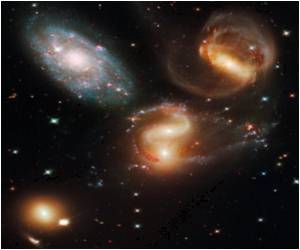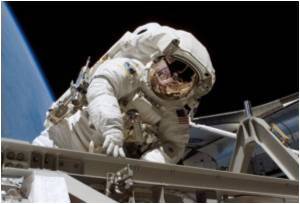
The findings provide the strongest support yet for lithopanspermia, the hypothesis that basic life forms are distributed throughout the universe via meteorite-like planetary fragments cast forth by disruptions such as volcanic eruptions and collisions with objects such as asteroids.
Eventually, another planetary system's gravity traps these roaming rocks, which can result in a mingling that transfers any living cargo.
Previous research on this possible phenomenon suggested that the speed at which objects hurtle through space made the chance of them being captured by another planet very small.
However, this new research, based on computer simulations of the star cluster our Sun was born in, suggests that a process called weak transfer, in which solid objects can gradually meander out of the orbit of one object and into another, greatly increase the odds that this process could have happened.
The research is based on principles of weak transfer developed by mathematician Edward Belbruno.
Advertisement
"Our work says the opposite of most previous work. It says that lithopanspermia might have been very likely, and it may be the first paper to demonstrate that. If this mechanism is true, it has implications for life in the universe as a whole. This could have happened anywhere," said Belbruno.
Advertisement
The researchers report that the solar system and its nearest planetary-system neighbor could have swapped rocks at least 100 trillion times well before the Sun struck out from its native star cluster. Furthermore, existing rock evidence shows that basic life forms could indeed date from the Sun's birth cluster days-and have been hardy enough to survive an interstellar journey and eventual impact.
Belbruno's collaborator Amaya Moro-Martin (Centro de Astrobiologia and Princeton University) said, "The conclusion from our work is that the weak transfer mechanism makes lithopanspermia a viable hypothesis because it would have allowed large quantities of solid material to be exchanged between planetary systems, and involves timescales that could potentially allow the survival of microorganisms embedded in large boulders."
The study shows that exchange of material between different planetary systems is likely, but it stops short when the solid matter is captured by the second planetary system. For lithopanspermia to actually take place, the material needs to land on an Earth-like planet where life could flourish.
"The study of the probability of landing on a terrestrial planet is work that we now know is worth doing because large quantities of solid material originating from the first planetary system may be trapped by the second planetary system, waiting to land on a terrestrial planet," said Moro-Martin.
"Our study does not prove lithopanspermia actually took place, but it indicates that it is an open possibility," he added.
The researchers presented their study at the European Planetary Sciences Congress (EPSC) and have also published in the recent issue of the journal Astrobiology.
Source-ANI









